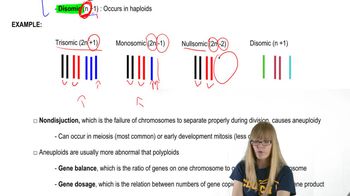How do we know that the extra chromosome causing Down syndrome is usually maternal in origin?
Table of contents
- 1. Introduction to Genetics51m
- 2. Mendel's Laws of Inheritance3h 37m
- 3. Extensions to Mendelian Inheritance2h 41m
- 4. Genetic Mapping and Linkage2h 28m
- 5. Genetics of Bacteria and Viruses1h 21m
- 6. Chromosomal Variation1h 48m
- 7. DNA and Chromosome Structure56m
- 8. DNA Replication1h 10m
- 9. Mitosis and Meiosis1h 34m
- 10. Transcription1h 0m
- 11. Translation58m
- 12. Gene Regulation in Prokaryotes1h 19m
- 13. Gene Regulation in Eukaryotes44m
- 14. Genetic Control of Development44m
- 15. Genomes and Genomics1h 50m
- 16. Transposable Elements47m
- 17. Mutation, Repair, and Recombination1h 6m
- 18. Molecular Genetic Tools19m
- 19. Cancer Genetics29m
- 20. Quantitative Genetics1h 26m
- 21. Population Genetics50m
- 22. Evolutionary Genetics29m
6. Chromosomal Variation
Chromosomal Mutations: Aneuploidy
Problem 7h
Textbook Question
From the following list, identify the types of chromosome changes you expect to show phenotypic consequences.
Monosomy
 Verified step by step guidance
Verified step by step guidance1
Understand the concept of monosomy: Monosomy refers to the loss of a single chromosome from a diploid organism, resulting in a chromosome number of 2n-1. This can lead to an imbalance in gene dosage, as the organism has only one copy of the genes on the missing chromosome instead of the usual two.
Review the phenotypic consequences of gene dosage imbalance: Gene dosage imbalance occurs when the number of copies of a gene is altered, which can disrupt normal cellular processes. In monosomy, the reduced gene dosage can lead to developmental abnormalities or lethality, depending on the chromosome affected.
Consider examples of monosomy in humans: For instance, monosomy of chromosome X (Turner syndrome) is viable and results in specific phenotypic consequences, such as short stature and infertility. However, monosomy of autosomes (non-sex chromosomes) is typically lethal due to severe gene dosage imbalance.
Analyze why phenotypic consequences occur: The phenotypic effects of monosomy arise because certain genes are dosage-sensitive, meaning their expression levels must be tightly regulated for normal development and function. The absence of one chromosome disrupts this balance.
Conclude that monosomy generally leads to phenotypic consequences: Based on the understanding of gene dosage and examples from human genetics, monosomy is expected to show phenotypic consequences due to the loss of genetic material and the resulting imbalance in gene expression.
 Verified video answer for a similar problem:
Verified video answer for a similar problem:This video solution was recommended by our tutors as helpful for the problem above
Video duration:
3mPlay a video:
Was this helpful?
Key Concepts
Here are the essential concepts you must grasp in order to answer the question correctly.
Monosomy
Monosomy is a chromosomal abnormality where one chromosome from a pair is missing. This results in a total of 45 chromosomes instead of the normal 46 in humans. Monosomy can lead to various phenotypic consequences, including developmental disorders and increased susceptibility to certain diseases, as the absence of a chromosome can disrupt normal gene function and expression.
Recommended video:
Guided course

Aneuploidy
Phenotypic Consequences
Phenotypic consequences refer to the observable traits or characteristics that result from genetic variations, including chromosomal changes. These traits can manifest in physical appearance, behavior, and physiological functions. Understanding how specific chromosomal alterations, like monosomy, affect phenotype is crucial for predicting the impact of genetic disorders on an organism.
Recommended video:
Guided course

Mutations and Phenotypes
Chromosomal Abnormalities
Chromosomal abnormalities are deviations from the normal number or structure of chromosomes, which can lead to genetic disorders. These abnormalities can be classified into numerical changes, such as aneuploidy (including monosomy and trisomy), and structural changes, such as deletions or duplications. Recognizing the types of chromosomal abnormalities is essential for understanding their potential effects on phenotype and health.
Recommended video:
Guided course

Chromosome Structure
Related Videos
Related Practice
Textbook Question
440
views


